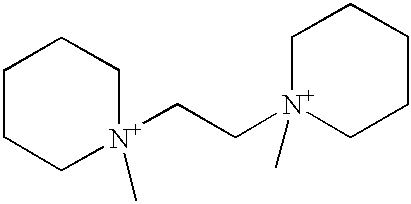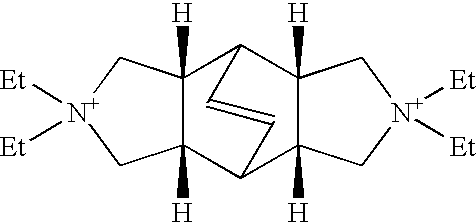Synthetic porous crystalline material, EMM-1, its synthesis and use
a porous crystalline material and porous crystalline technology, applied in the field of zeolitic materials, can solve problems such as not being detected experimentally
- Summary
- Abstract
- Description
- Claims
- Application Information
AI Technical Summary
Benefits of technology
Problems solved by technology
Method used
Image
Examples
example 2
Synthesis of EMM-1 Using (methylpiperidine).sub.2 -Diquat.sub.2 Dihydroxide
example 1
but with the mole ratios of the reactants being as follows:
After the reaction was over, the solid was recovered by filtration and washed with DI water and dried under infra-red lamps in air. The material thus obtained had the powder X-ray diffraction pattern shown in FIG. 4 demonstrating that the material was composed of EMM-1 with some amount of quartz as an impurity.
example 3
Synthesis of EMM-1 Using Benzyltrimethyl Ammonium Hydroxide
10.0 grams of Syton.RTM. HT-50 colloidal silica (50 wt % solution), 12.0 grams of benzyltrimethyl ammonium hydroxide solution, 1.74 grams of germanium oxide and 1.04 grams of HF (48 wt %) were added to a 30 mL plastic bottle. The mixture was homogenized, the bottle was placed into and autoclave, and then the autoclave was ramped to 150.degree. C. and held for 336 hours. The mole ratios of the reactants were as follows:
After the reaction was complete, the solid was recovered by filtration, washed with DI water and dried under infra-red lamps in air. The material thus obtained had the powder X-ray diffraction pattern for pure EMM-1 shown in FIG. 5. The as-synthesized material was calcined at 540.degree. C. for 8 hours in nitrogen and subsequently for 8 hours in air and the calcined material had the X-ray pattern shown in FIG. 6.
PUM
| Property | Measurement | Unit |
|---|---|---|
| temperature | aaaaa | aaaaa |
| angle | aaaaa | aaaaa |
| temperature | aaaaa | aaaaa |
Abstract
Description
Claims
Application Information
 Login to View More
Login to View More - R&D
- Intellectual Property
- Life Sciences
- Materials
- Tech Scout
- Unparalleled Data Quality
- Higher Quality Content
- 60% Fewer Hallucinations
Browse by: Latest US Patents, China's latest patents, Technical Efficacy Thesaurus, Application Domain, Technology Topic, Popular Technical Reports.
© 2025 PatSnap. All rights reserved.Legal|Privacy policy|Modern Slavery Act Transparency Statement|Sitemap|About US| Contact US: help@patsnap.com



